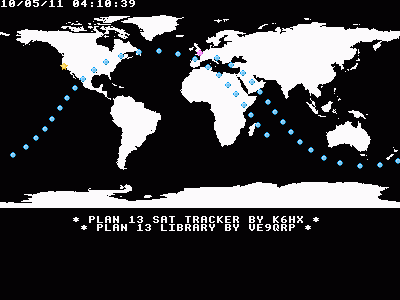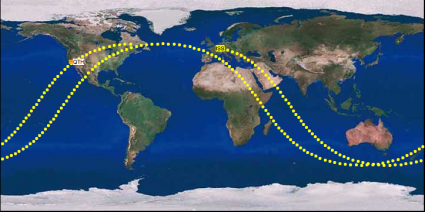I need to think up a better name for this project. Calling it the “Arduino/Gameduino Satellite Tracker” is just too damned cumbersome for words.
Progress was slow today. I woke up around 4:00AM with a sore throat and a miserable cough. A quick trip to the urgent care clinic when it opened reassured me that I didn’t have strep throat, but I do have some kind of upper respiratory infection going. Lots of rest today. I did spend a couple of hours listlessly programming and watching the Tigers/Rangers game though, the main result being I now plot the position of the sun on the map:
While the text at the bottom still says “ISS”, the satellite being tracked is actually AO-51. As you can see, it is a polar orbiting satellite, and reaches much greater latitudes than the ISS.
I’ve been trying to remodularize the original Plan 13 code in BASIC, and that has made me go through the code and restructure it a bit. The solar calculations in Plan 13 are actually a bit odd: it goes through the trouble of converting the sun’s orbital elements into the same epoch as the satellite you are watching, mostly so you can reuse the “T” variable. It’s actually quite a bit simpler to just use the sun’s orbital elements directly, and that means the sun can be a completely independent object.
I’ve also got a bit more hardware on the way. I decided I wanted to store a fairly large number of satellite elements, so I ordered some AT24C1024 serial EEPROMS with a capacity of 128Kbytes. I can easily chain up to 4 of those together, to store 512K which should be more than enough.
I’ve also got some Zigbee radios coming, so I can send new orbital elements and synchronize the time easily from my desktop. (It’s mostly an excuse to play with Zigbee, but it will make for a nice setup).
After the clinic this morning, I stopped by Fry’s in Walnut Creek and found that they carry OSEPP’s clones of the Arduino. I’d rather spend my money at Sparkfun, but it’s nice to have a local supplier for those moments where immediate gratification is essential. I bought one of their OSEPP FIO boards, which have sockets in place for Zigbee modules. What I didn’t realize is that these boards aren’t programmable over USB: I’ll have to get one of those FTDI serial boards. For now, it will sit in its plastic case until I have need of it. It is cool that the FIO is actually cheaper than the Zigbee shield that I ordered. I’ll figure out some reason to use one.
I’ll shoot another video once I get multiple satellites loaded and some improvements in the user interface.
Addendum: It dawned on me that one way to test my solar calculations was to run them at the same time every day and see if the sun traced out an Analemma, the figure-eight shaped curve that you might have seen on a globe and given very little thought to. What’s cool is my simulation shows this effect pretty clearly.






